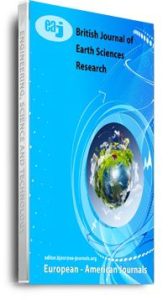The Geology and geochemistry of Lead-Zinc Mineralization has been carried out in parts of Ameri, South eastern Nigeria. The study area was mapped and lithological units and structural features were identified and studied. A total of twenty-seven (27) samples from five (5) wells (AMR 014, AMR 036, AMR 038, AMR 048, and AMR 049) of the study area were collected, prepared and subjected to geochemical analysis for both major and trace elements using EDX3600B X-ray fluorescence spectrometer. The analytical data were statistically computed using principal component factor analysis PCFA, statical package for social science SPSS, descriptive statistics DS, correlation matrix CM and were also adopted for various geochemical plots using Excel Microsoft office, geochemical data kid GCD Kid and Suffer software for geological map digitization, to determine the geochemical characteristics of the Lead-Zinc ore, the host rock and the environment of formation. The geology of the study area is strategically part of the Lower Benue Trough of Nigeria, it is made up of shale intruded by several small to medium sized mesocratic – melanocratic, phaneritic intrusives which are alkaline in nature with a slight variation in their mineralogical and textural characteristics. Structurally, the fractured zones or veins marked along the Enyigba and Ameka lodes could also be responsible for the mineralization of the Ameri Lead-Zinc. The Lead-Zinc in Ameri is associated with other gangue minerals such as marcasite, pyrite, quartz veins, carbonate materials, chalcopyrite, siderites, sphalerites and it shows that the Lead-Zinc mineralization in the study area is hosted by shales, which are probably parts of the slightly deformed cretaceous sedimentary rocks made up of essentially Albian shales and subordinate siltstones. Values of lead within this shear zone ranges from 0.06% – 64.58%, 0.02% – 64.35%, 0.01% –0.14%, 0.03% – 0.11% for AMR 036, AMR 038, AMR 048, AMR 049 respectively, while Zn ranges in value from; 0.09% – 53.98%, 0.08% – 1.11%, 0.19% – 58.64%, 0.08% – 56.11%. The value of lead and zinc within the hanging wall are 0.06% and 0.08%, 0.03% and 0.06%, 0.04% and 0.12%, 0.04% and 0.13% for AMR 036, AMR 038, AMR 048, AMR 049 respectively. Paleo-redox condition of Low Cu/Zn ratios from 0.001-0324, 0.001 – 0.307, 0.075-0.424, 0.001-0.309 and 0.001-0.321 for AMR 014, AMR 036, AMR 038, AMR 048, AMR 049 indicate more oxidizing conditions. This is confirmed by the Ni/Co ratio of 0.00-58.50, 0.00- 43.625, 0.00- 35.333, 0.00-1.704, 0.211- 1.472 for AMR 014, AMR 036, AMR 038, AMR 048, AMR 049 respectively mostly below the ratio indicated to be oxidic with little anoxic environmental affinity. The total Alkalis versus Silica plot from the intrusaive revealed their basic to ultrabasic nature, as the bivariate plots of the analyzed samples shows positive and /or strong relationship between the trace elements in the Ameri lodes and their respective certified concentration values which is also an indicator that the elements are probably from same hydrothermal source with the Lead-Zinc of the study area.
Keywords: Ameri, Geochemistry, geology, mineralization, paleo-redox and structure.

